The Ultimate Guide to Sales Analytics in 2024
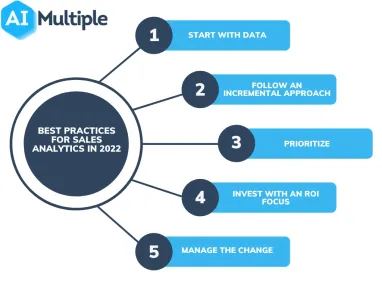
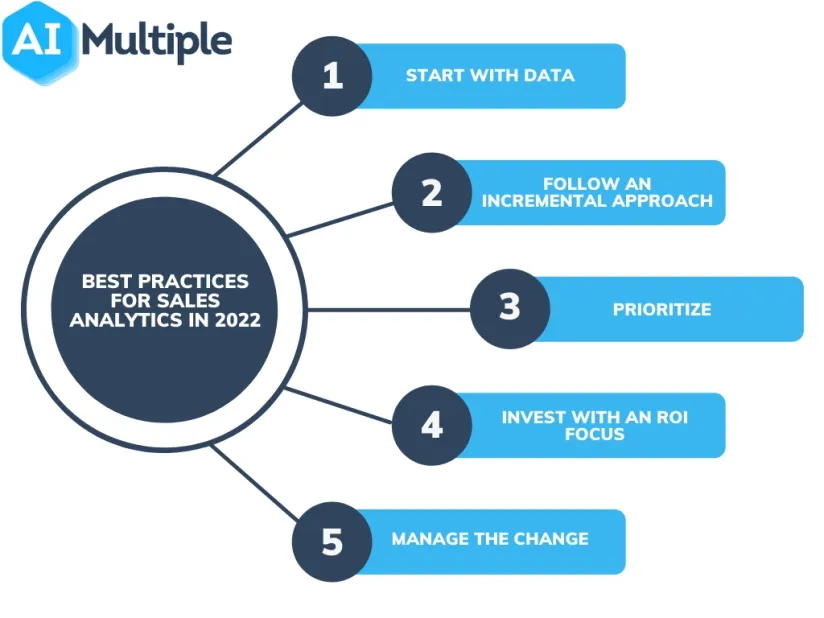
Unlike marketing, sales has always been numbers driven and now with the explosion of data and computational power, sales analytics has become central to any large sales organization. Companies can take advantage of sales analytics for forecasting to performance management to increase sales effectiveness and enable sales personnel to focus on sales rather than analytics.
What is sales analytics?
Sales involves making many decisions with limited data. Sales analytics helps uncover insights and increasingly recommends the best decisons to sales reps and managers.
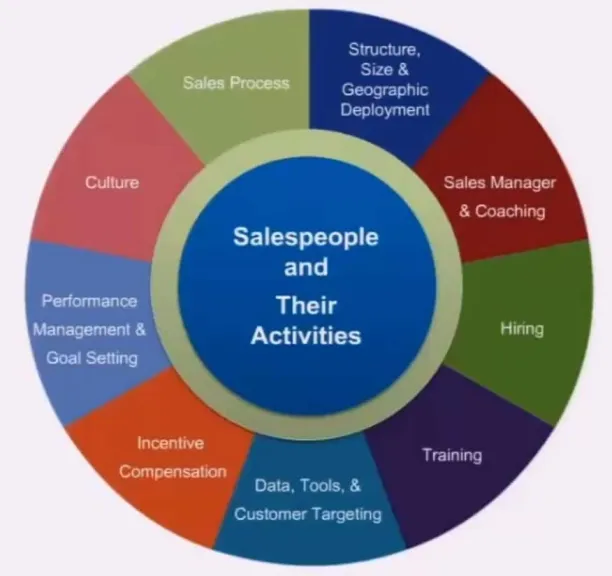
Relevant data sources include most data used by marketing departments such as account level and lead level digital history and preferences along with rich data on all sales rep interactions such as call logs and emails.
For those in favor of more dictionary-style definitions, Gartner has a sufficiently formal and wordy definition:
Sales analytics is used in identifying, modeling, understanding and predicting sales trends and outcomes while aiding sales management in understanding where salespeople can improve. Sales analytic systems provide functionality that supports discovery, diagnostic and predictive exercises enabling the manipulation of parameters, measures, dimensions or figures as part of an analytic or planning exercise.
What are the different types of sales analytics?
Most analysts break sales analytics applications into 3 or 4 categories in terms of their output. The categorization that makes the most sense to us is:
- Descriptive: Summarized, prioritized observations from sales related data. Example: spike in sales of a certain product in the professional services industry in a certain region.
- Diagnostic: Possible explanations for observations from sales related data. Example: Customers in the automotive industry are spending less time to call a sales rep. Increased competition in the industry could be pushing companies to invest in our product.
- Predictive: Based on diagnostic results, predictions are made. Example: Leads from the professional services industry in a certain region get higher scores. As a result, sales reps spend more time on those leads
- Prescriptive: Predictive analytics results are explained and the sales rep is provided with a clear game plan. Example: Sales reps get tactics before calls to underline certain aspects of the product that are important to the customer.
What are the top sales analytics applications?
Almost all advanced sales applications rely on sales analytics. Some prominent examples are:
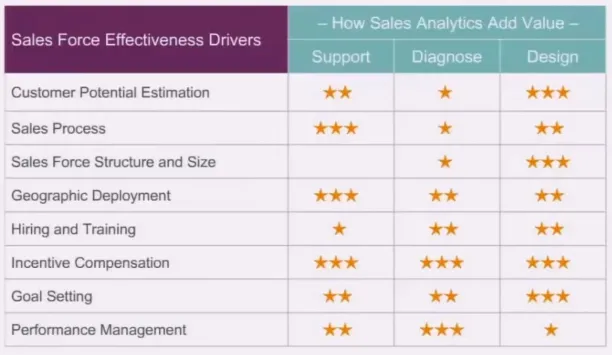
The full list of applications we have seen are:
- Sales forecasting
- Sales force management
- Sizing
- Geo-distribution
- Predictive/prescriptive lead scoring
- Customer contact analytics
- Sales rep compensation improvements
- Sales attribution between marketing and sales
- Sales process improvements
- Performance management
What are the benefits of sales analytics?
Implementing a sales analytics system brings increased accountability and increases understanding of the factors that impact sales.
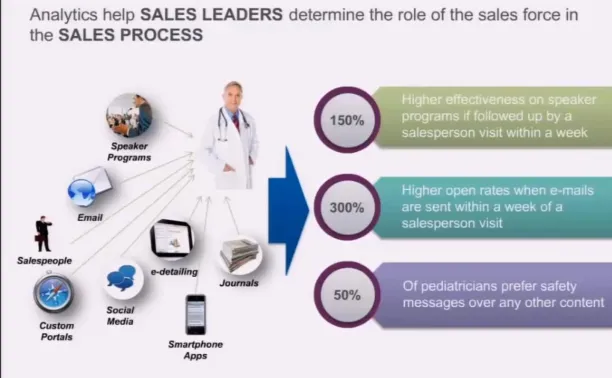
Additionally, sales analytics enables numerous applications we listed above. Some of these applications have dramatic benefits:
Reduction of sales support activities

Sales reps spend more time on non-sales activities according to most research on the topic. These include making sales forecasts, prioritizing leads, and deciding how to approach leads which can all be automated with sales analytics applications. To perform such tasks, sales reps can use behavioral analytics.
Improved prioritization
There are several levels of improved prioritization thanks to sales analytics:
- Predictive/prescriptive lead-scoring techniques enable improved prioritization by sales reps
- Sales rep compensation can be improved with advanced analytics enabling the company to focus on successful sales reps
- Sales attribution models allow the company to focus its resources appropriately between sales and marketing.
Improved sales processes and practices
Insights can lead managers to learn from top performers, and improve their coaching and sales processes as outlined in the example below.
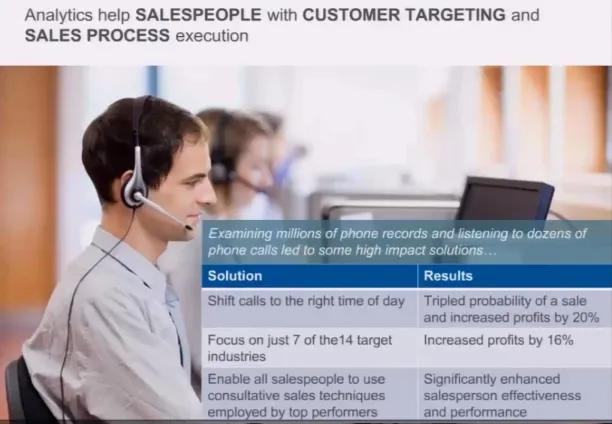
What are the limitations of sales analytics?
Sales analytics makes sense for large organizations with at least
- ten sales reps
- tens of sales
- a stable product and target market so the target customer behavior does not change dramatically every day
If all your data fits in a spreadsheet and what you are selling changes from today to tomorrow it may be overkill to invest in advanced tools.
Additionally, some sales analytics suffer from the limitations of modern AI systems such as not providing explanations for the outputs they provide.
How do sales analytics systems work?
There is essentially a prediction problem at the heart of sales analytics. The answer to the question “Who will buy your product?” feeds on your customer’s interactions with your sales reps, interactions on your & external digital properties and powers forecasts, lead scores, and sales attribution.
Who takes care of sales analytics?
Most of the time, especially in B2B sales organizations, sales operations teams are in charge of sales analytics. However, it could also be under sales, marketing, or a central analytics organization.
Best practices
- Start with data: Unless data federation and quality are well established, it is not possible to set up a competent sales analytics operations
- Follow an incremental approach: Rolling out multiple sales analytics applications would be challenging. Systems recommendations should be challenged during roll-out to ensure that systemic biases are uncovered and fixed.
- Prioritize: Not all sales analytics applications are appropriate for all companies. If for example, sales forecasting does not take a significant portion of sales rep time and if the analytics solution to enable auto-forecasts is expensive, it should not be the first sales analytics application to be rolled out.
- Invest with an ROI focus: Competition, regulation, and other market conditions all introduce randomness into a company’s sales performance so it is difficult to measure the impact of your sales analytics investments. This leads most such investments to get approved without a robust review. However, estimating the ROI of analytics investments is still an important exercise as analytics tools can be expensive to maintain and companies with limited profitability should reconsider sales analytics investments if they are not seeing returns.
- Manage the change: Your sales reps need to focus on selling and will have limited patience to deal with analytics tools’ bugs and changes in their selling process especially if it requires for them to enter more data into the system. Extensive testing, pilots, and communicating process changes early and often can solve most of these problems.
Vendor landscape
CRM companies and other incumbents
Sales analytics systems are data hungry and the vendors that own systems providing data for sales analytics build their own sales analytics tools to deepen their customer relationships.
For example, Salesforce is heavily investing in its AI products under the Einstein brand, offering a sales analytics tool as well.
End-to-end sales analytics solutions
Companies like insidesales.com use data from CRM systems like Salesforce to provide their sales insights. Having raised >$250M insidesales.com is one of the juggernauts in this space.
Focused sales analytics solutions
Some vendors focus on specific areas of sales analytics like lead scoring. Feel free to read our guide on lead scoring to learn more.
Feel free to learn more about our AI in the sales section.
Also, don’t forget to check out our sortable/filterable data-driven lists of sales intelligence software vendors and sales analytics software vendors.

Cem has been the principal analyst at AIMultiple since 2017. AIMultiple informs hundreds of thousands of businesses (as per similarWeb) including 60% of Fortune 500 every month.
Cem's work has been cited by leading global publications including Business Insider, Forbes, Washington Post, global firms like Deloitte, HPE, NGOs like World Economic Forum and supranational organizations like European Commission. You can see more reputable companies and media that referenced AIMultiple.
Throughout his career, Cem served as a tech consultant, tech buyer and tech entrepreneur. He advised businesses on their enterprise software, automation, cloud, AI / ML and other technology related decisions at McKinsey & Company and Altman Solon for more than a decade. He also published a McKinsey report on digitalization.
He led technology strategy and procurement of a telco while reporting to the CEO. He has also led commercial growth of deep tech company Hypatos that reached a 7 digit annual recurring revenue and a 9 digit valuation from 0 within 2 years. Cem's work in Hypatos was covered by leading technology publications like TechCrunch and Business Insider.
Cem regularly speaks at international technology conferences. He graduated from Bogazici University as a computer engineer and holds an MBA from Columbia Business School.
To stay up-to-date on B2B tech & accelerate your enterprise:
Follow onNext to Read
The Ultimate Guide Into Digital Shelf Analytics in 2024
Ultimate Guide To Outsourcing B2B Lead Generation in 2024
Retail Analytics in 2024: Uncover Retail Insights with AI
This is a good article . I would like to receive more information on sales analytics
Comments
Your email address will not be published. All fields are required.